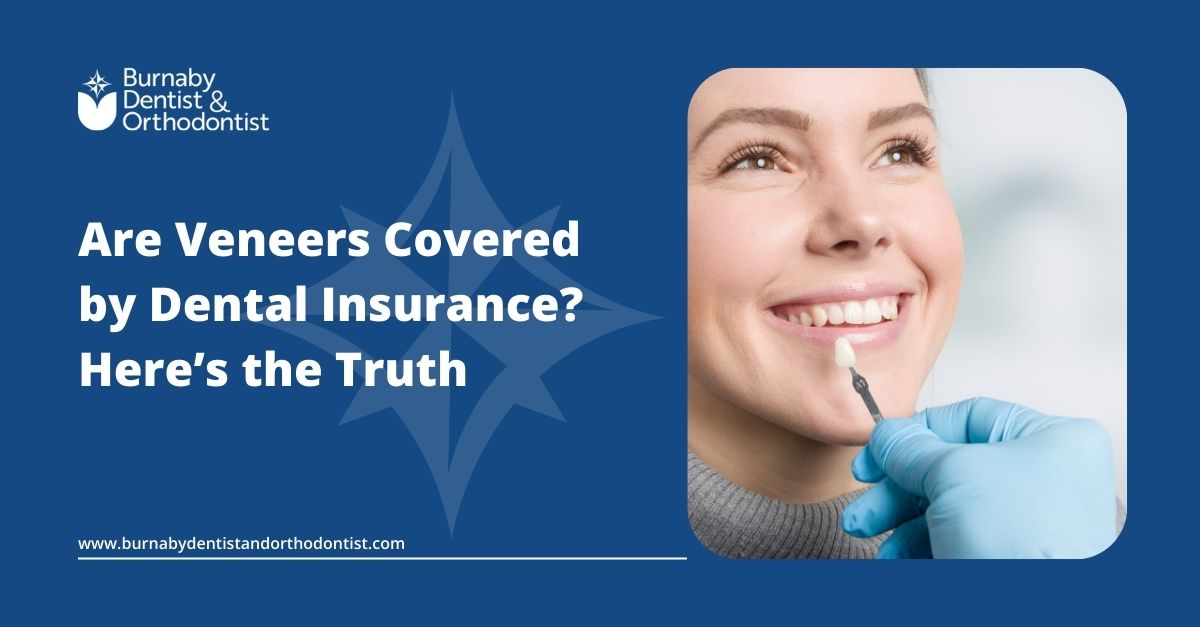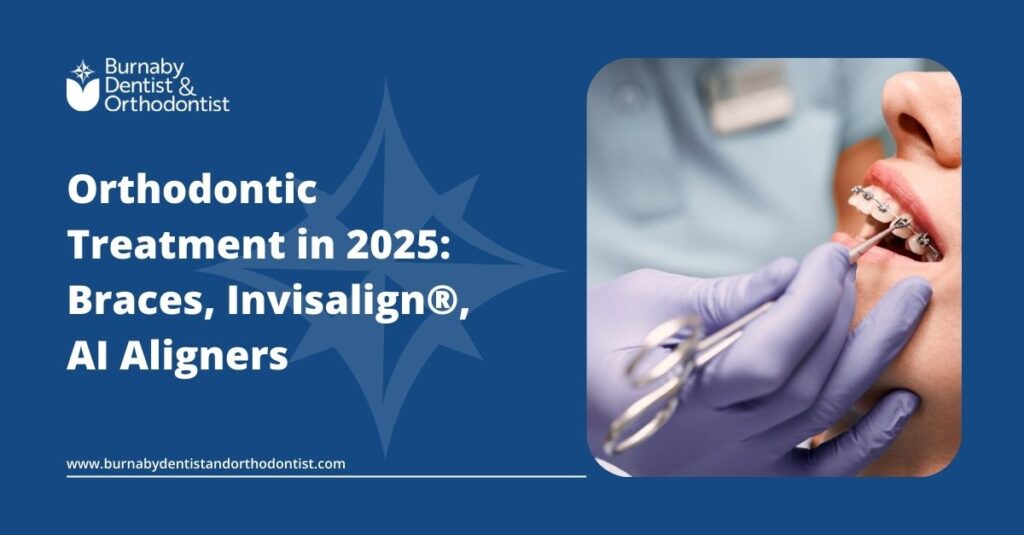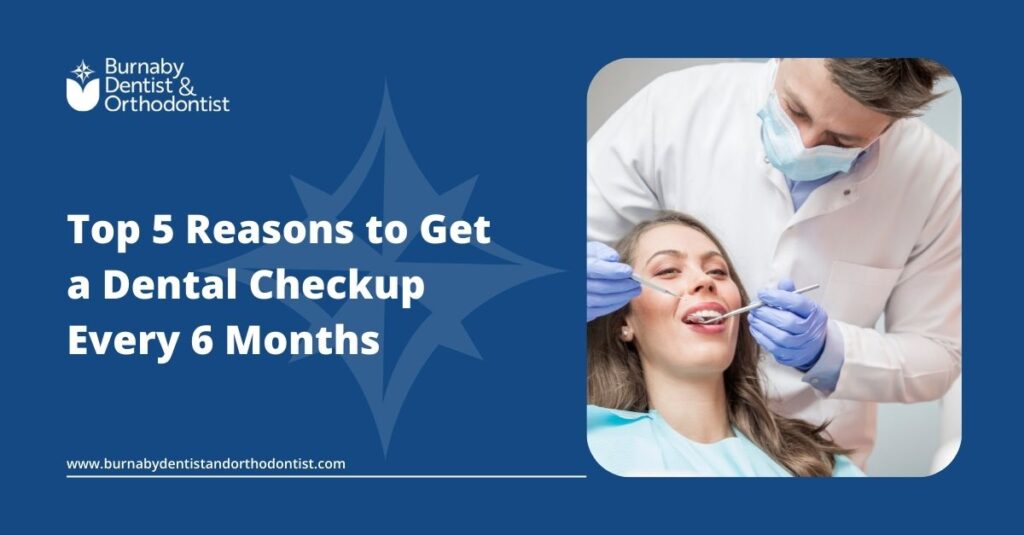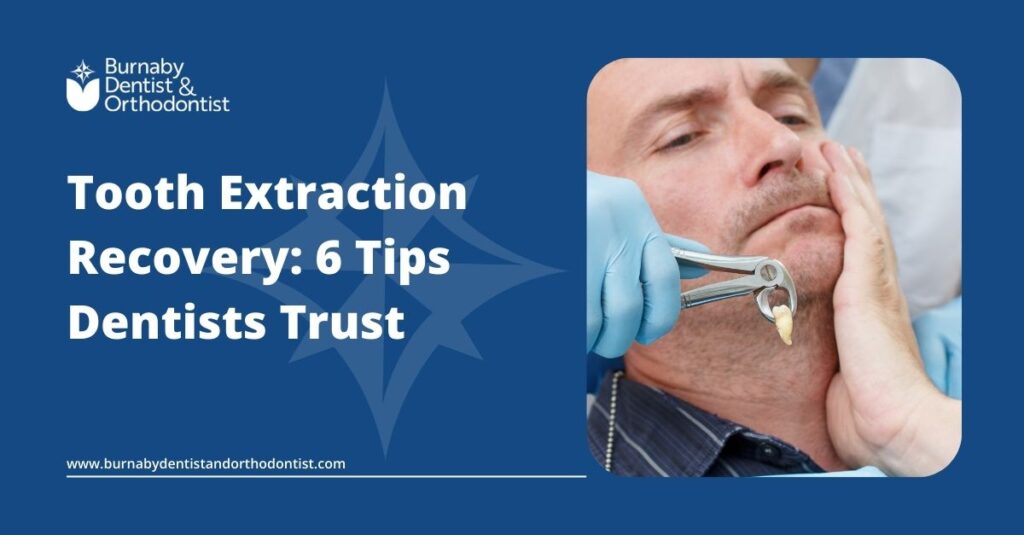You may have heard, “Insurance won’t cover veneers.” That’s usually true—but not always. While most plans across Canada classify veneers as cosmetic and exclude them, a few exceptions exist. And understanding those exceptions—before you commit—can save you money, frustration, and time.
If you’re exploring dental veneers in Burnaby or Vancouver, this guide helps you navigate the fine print, understand what’s typically covered instead, and how to make a smart, affordable plan with or without insurance.
At a Glance:
Veneers are usually considered cosmetic and aren’t covered by Canadian dental insurance or CDCP. However, some patients may qualify if veneers are needed for functional reasons—such as restoring a damaged or eroded tooth.
Alternatives like bonding or crowns may be covered. At Burnaby Dentist & Orthodontist, we guide you through your options clearly, offer flexible payment plans, and help you choose the right solution for your goals.
Why Most Insurance Plans Don’t Cover Veneers
Dental veneers are often viewed as luxury treatments—not because they aren’t useful, but because they’re primarily aesthetic.That’s the key reason most Canadian dental insurance plans, including the CDCP, don’t cover them.
To qualify for reimbursement, a procedure must be classified as medically necessary—and that’s where veneers typically don’t make the cut.
Elective vs. Necessary: How Insurers Classify Veneers
Insurers divide dental treatments into two buckets:
- Elective (cosmetic): These improve the appearance of teeth but not their function. Veneers often fall into this category—used to enhance colour, shape, or close small gaps.
- Restorative (medically necessary): These protect or restore dental structure, reduce pain, or prevent further damage. Crowns and fillings typically qualify here.
Because veneers don’t usually restore function, they’re considered elective. That classification makes them ineligible under standard plan criteria—even if they dramatically improve your smile or confidence.
But It’s Not Always That Simple
Sometimes, what seems cosmetic can be classified as restorative—if documented correctly. For example, if a veneer is required to restore a tooth after a fracture or acid erosion, there’s a case to be made for medical necessity.
At Burnaby Dentist & Orthodontist, we assess each case carefully. If there’s a legitimate functional reason for using veneers, we help you prepare the documentation your insurer needs to consider partial coverage or an exception.
When Veneers Might Be Covered by Insurance in Canada
Even though most insurance plans exclude veneers as a cosmetic expense, there are rare exceptions—especially if the treatment addresses a legitimate health concern. Coverage is not guaranteed, but with the right documentation, it’s possible to make a case.
Functional Use vs. Cosmetic Desire
If your veneer is required to repair damage from trauma, severe erosion, or developmental defects, it may be considered restorative instead of elective. That’s the only scenario where coverage becomes a possibility.
Insurance plans may be more flexible if:
- A tooth was fractured in an accident
- You’ve experienced significant enamel loss due to acid wear
- Your teeth show signs of congenital malformation or structural defects
- Bite misalignment has caused visible wear or function issues
In these cases, a veneer isn’t just cosmetic—it restores form and function. That’s the line insurance companies look for, and it needs to be clearly supported in your treatment notes and documentation.
Documentation Makes the Difference
If there’s any chance your veneer could qualify as a restorative procedure, your dentist must document:
- The clinical reason for the veneer
- Why alternative options (like bonding or crowns) may not be suitable
- Supporting evidence like photos, x-rays, or intraoral scans
At Burnaby Dentist & Orthodontist, we review your medical and dental history thoroughly. If there’s a functional justification for a veneer, we build a claim file that increases your odds of partial reimbursement—even if the default answer from your plan is “no.”
What insurance covers (and doesn’t) when veneers aren’t an option
If you’ve heard “veneers aren’t covered,” you’re not being misled—but you might be missing the full picture. Veneers are classified as elective under nearly all Canadian dental plans, including the Canadian Dental Care Plan (CDCP).
However, restorative alternatives that improve dental health—not just appearance—may qualify for partial or full coverage.
What’s Not Covered
According to CDCP1 and most private plans, the following are usually excluded:
✘ All veneer types (porcelain and composite)
✘ Inlays, onlays, and partial crowns
✘ Fixed bridges and implant-supported restorations
✘ Cosmetic-only treatments such as tooth whitening or contouring
✘ Appliances for bruxism or aesthetic correction
Even if these treatments support your self-esteem or daily comfort, insurers won’t approve them unless they address a functional issue.
What Can Be Covered—When It’s Restorative
Instead of veneers, the following procedures may be eligible for reimbursement if they’re medically necessary:
- Dental Crowns: When a tooth is fractured, heavily filled, or structurally weakened, a crown may be covered as a protective and restorative measure.
- Composite Bonding: Small chips, worn edges, or minor spacing can often be addressed with bonding. It’s more affordable, reversible, and typically eligible when function is affected.
- Tooth-Coloured Fillings: If the goal is to rebuild worn enamel or repair decay—not just make a tooth whiter—insurance will usually support composite fillings on front teeth.
- Occlusal Adjustments: Bite problems sometimes contribute to enamel wear or chipping. Corrections like reshaping the bite or fitting a nightguard may be partially covered if tied to a clinical condition.
If you’re unsure which direction makes the most sense financially or clinically, we help you weigh your options.
At Burnaby Dentist & Orthodontist, we clarify what qualifies for reimbursement and whether veneers are truly the best path—or if a covered alternative might achieve your goal more affordably.
How to Plan Financially for Veneers
Being told “veneers aren’t covered” doesn’t mean they’re out of reach—it just means you need a smart plan. Cosmetic care isn’t spontaneous; it’s strategic. And it starts with knowing your numbers, timelines, and options.
Start with a Personalized Consultation and Quote
At Burnaby Dentist & Orthodontist, we don’t offer vague estimates. We assess your smile goals and clinical needs first, then create a tailored veneer treatment plan that includes:
✔ A precise quote for each veneer
✔ Honest advice on restorative alternatives (like crowns or bonding)
✔ A review of whether parts of your case could be eligible for insurance, with documentation support if needed
We also explain if it’s worth submitting for pre-authorization—particularly if you’re considering a mixed case involving both cosmetic dentistry and restorative treatment.
Financing Options at Burnaby Dentist & Orthodontist
Cost shouldn’t be a barrier to a confident smile. That’s why we offer payment flexibility that suits different budgets and timelines:
✅ In-House, No-Interest Financing: Spread payments over time with no hidden fees or third-party approvals.
✅ Custom Scheduling: Break your treatment into stages to match financial or personal milestones.
✅ Transparent Quotes: Know your full investment upfront—no surprises, no pressure.
Whether you’re ready now or planning for later, we’re here to make veneers realistic—not rushed or overwhelming.
If you’re weighing your cosmetic options beyond insurance, our guide on Dental Veneers or Bonding? breaks down the pros, cons, and costs of each treatment.
Why Veneers Are Still Worth It, Even Without Insurance
For many patients, veneers feel like a luxury—especially when insurance doesn’t contribute. But if you’re unhappy with your smile or self-conscious about chipped, discoloured, or worn teeth, veneers offer benefits that go beyond aesthetics.
Confidence That Feels Natural
Porcelain and composite veneers are custom-crafted to match your face, features, and bite. They restore symmetry, brighten your smile, and cover imperfections in a way that still looks entirely natural. It’s not about creating a celebrity grin—it’s about enhancing your own.
Long-Lasting Results with Minimal Maintenance
High-quality veneers are stain-resistant, durable, and easy to care for. With proper hygiene and regular dental checkups, they can last 10–15 years or longer. You don’t need to whiten them. You don’t need to replace them every few years. They’re a long-term investment in your smile and self-image.
A Smart Option for Minor Cosmetic & Functional Issues
While some patients turn to veneers purely for appearance, others use them to address slight misalignment, minor enamel damage, or uneven spacing. In these cases, veneers may provide a quicker and less invasive solution than orthodontic treatment or full crowns.
Patients Rarely Regret the Decision—Only the Delay
Cost is always a consideration. But many patients tell us the bigger regret was waiting too long to fix something that impacted their daily confidence. If you’re considering veneers but unsure how to start, we’re here to help with clarity, not pressure.
Why Choose Burnaby Dentist & Orthodontist for Veneers in Vancouver
If you’re investing in your smile, the provider matters as much as the product. At Burnaby Dentist & Orthodontist, we treat cosmetic dentistry as a blend of art and science—not one-size-fits-all.
Our approach to veneers focuses on:
✅ Individualized Design: Each veneer is crafted to harmonize with your face shape, lip line, and natural tooth shade. We tailor the process so your smile looks enhanced—not artificial.
✅ Functional & Aesthetic Balance: We don’t just cover flaws; we ensure your bite stays balanced, and your enamel is protected for long-term oral health.
✅ Clear Communication: From costs and timelines to maintenance and expectations, our team ensures you feel confident about your treatment decisions every step of the way.
✅ Cosmetic Experience: Our team has experience handling everything from single-tooth corrections to full smile transformations, always with attention to the details that matter.
At our Burnaby clinic, your veneer journey is designed for comfort, realism, and lasting results—whether you’re repairing damage or upgrading your look.
Conclusion
Veneers can be transformative—but understanding their cost, limitations, and coverage shouldn’t be confusing. In Canada, most dental insurance providers classify veneers as elective and won’t cover them.
However, there are exceptions when there’s a functional or medical need—and planning ahead can help you avoid unexpected costs.
At Burnaby Dentist & Orthodontist, we make the process practical and transparent. From honest guidance to flexible, interest-free financing, we help you explore whether veneers, crowns, or bonding align best with your goals.
If you’re ready to improve your smile or just want answers from a team that cares about the full picture, we’re here to help.
Book a consultation today and take the first step with confidence.
Are veneers ever covered by dental insurance?
Usually not. Veneers are considered cosmetic, but some exceptions apply—such as when they restore function after trauma. Supporting documentation from your dentist is required.
Why aren’t veneers covered in Canada?
Veneers are considered elective and non-essential because they typically improve appearance rather than restore function—hence they’re excluded from most plans, including the CDCP.
Can I get veneers covered if they’re for damage, not cosmetics?
Possibly. If your dentist can demonstrate medical necessity—such as enamel erosion, fractures, or bite correction—some insurers may partially cover treatment, though it’s not guaranteed.
What’s the difference between veneers and crowns when it comes to coverage?
Crowns are usually covered if needed to restore tooth strength or structure. Veneers, by contrast, are seen as aesthetic solutions and excluded unless part of a documented restorative treatment.
Do dental plans in Canada cover any cosmetic procedures?
Most don’t. Veneers, teeth whitening, inlays, and onlays are generally excluded from both public plans (like the CDCP) and most private dental policies.








